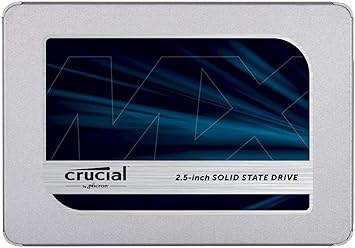Crucial MX500 500GB Sata III

The Crucial MX500 is a 500GB internal SSD featuring 3D NAND technology and a SATA III connector. It offers sequential read speeds of up to 560MB/s and sequential write speeds of 510MB/s, making it a solid choice for enhancing system performance.
Popularity: Medium
Performance:
Specifications:
Model: Crucial MX500 500GB Sata III
Capacity: 500.0 GB
Sequential Read Speed: 560 MB/s
Sequential Write Speed: 510 MB/s
Form Factor: 2.5-inch (7mm)
Interface: SATA (6Gb/s)
Random Read Speed:
Random Write Speed:
Controller:
NAND Type:
Cache Memory:
Endurance (TBW): 180TB
Power Consumption:
Operating Temperature:
Manufacturer Page: Link
Review
The Crucial MX500 500GB SSD remains a formidable contender in the world of SATA SSDs, offering a blend of performance and reliability that appeals to both everyday users and tech enthusiasts. This SSD distinguishes itself with its use of 3D NAND technology and features a SATA III interface, providing sequential read speeds of up to 560 MB/s and write speeds up to 510 MB/s.
Performance Analysis
The sequential read and write performances are key highlights of the MX500 SSD. In tests conducted by AnandTech, the MX500 impressively matches the burst sequential read performance of rival TLC SSDs and even outpaces the Samsung 860 PRO by a few MB/s in certain conditions [AnandTech]. However, sustained reads show that while the MX500 improves upon its predecessor, it doesn’t fully outshine Samsung’s offerings.
When it comes to sequential write performance, the MX500 is competitive, tying with the Samsung 850 EVO as one of the fastest TLC SSDs, showing significant improvement over the older MX300 model. Nevertheless, sustained sequential writes reveal a slight performance decrease from the MX300, suggesting an ongoing challenge with sustained loads [AnandTech]. Additionally, during write-intensive tasks typical of large file transfers, the SSD maintains its performance without significant drops, making it superior to other TLC SSDs which frequently drop to the 200 MB/s range [TechPowerUp].
Random Access Performance
The Crucial MX500 500GB SSD also holds its ground in random read performance. It outpaces most other TLC SSDs on burst performance, although it loses its edge at higher queue depths, surpassed by the Samsung 850 EVO and Intel SSDs in sustained tests [AnandTech]. As for random writes, the MX500 does lag in speed compared to similar drives, performing below its 1TB counterpart, though still manages good power efficiency [AnandTech].
Design and Features
Inside its sturdy 2.5-inch chassis, the MX500 employs Micron's 64-layer 3D TLC NAND technology and a Silicon Motion SM2258 controller, a strategic choice that enables it to balance cost with efficiency [TechPowerUp]. Dynamic Write Acceleration is one of the standout features, utilizing an SLC cache that dynamically adjusts based on available capacity to optimize speed and efficiency [LatestInTech]. The drive is also backed by a comprehensive suite of software utilities, including Crucial's Storage Executive for managing performance and firmware updates.
Endurance and Reliability
Endurance is another strength of the Crucial MX500, rated at 180 TBW (Terabytes Written), providing users with confidence for long-term use. Coupled with a five-year warranty, it underscores Crucial’s reputation for reliability and quality. The SSD includes advanced security features such as AES 256-bit encryption, RAIN, and TCG Opal 2.0 compliance, ensuring comprehensive data security [LatestInTech].
Conclusion
Overall, the Crucial MX500 500GB SSD is a robust solution for users seeking both performance and value. While it falls slightly behind some competitors in specific tests, its real-world performance, reliability, and supportive tools make it a leading choice in the SATA SSD market. Whether you're upgrading a home PC or outfitting a fleet of business machines, the MX500 offers dependable speed and efficiency that seldom disappoints [LatestInTech].